n the context of urban land-use growth and the consequent impacts on the environment, green spaces provide ecosystem services for human health. The ecosystem services concept synthesises human–environmental interactions through a series of combined components of biodiversity and abiotic elements, linking ecological processes and functions. The concept of green infrastructure (GI) in the urban context emphasises the quality and quantity of urban and peri-urban green spaces and natural areas.
- urban green roofs
- community gardens
- Urban ecology
- Urban planning
- ecosystem services
- green infrastructure
1. Introduction
Urban land use is the main cause of environmental impacts at both local and global scales [1] Even though it represents only 2% of global land use, about half of the world’s population lives in urban areas and most of the industrial activities are located here[1][2]. In 2019, the urban population in the European Union was already 75% of the total population, while the ratio in North America was 80% and in Asia it was about 40%[3]. The number of cities with at least one million inhabitants will be almost duplicated until 2030: in 2000, the amount was 371 and it is predicted to rise to 706 in 2030 [4]. Approximately 90% of urban growth happens in developing countries, and Asia will have more than 60% of the urban population of the world by 2050. Additionally, the number of megacities (with over 10 million inhabitants) will grow, especially in Asia and Africa[5].
The use of green infrastructure (GI) is mainly based on the conditions that the city is experiencing: the size of the city, how fast it is growing, the economic situation and opportunities to support the green approach in urban renewal. In an ideal situation, GI has two different components, hubs and links, where the hubs are based on different kinds of green areas (for example public spaces, parks, forests etc.) and the links are the interconnections between the areas facilitating the flow of ecosystems, working as green corridors[6][7]. Another aspect is what kind of role urban GI has in urban planning; many rapidly growing cities are already lacking sufficient green spaces and infrastructure. Oijstaeijen et al. [8] claimed that the main reasons for not adapting urban GI in planning relate to a lack of knowledge regarding its costs, benefits and impacts[9].
One option to manage the lack of GI has been the launching of different systems to support a sufficient number of green areas, namely the Green Space Factor (GSF) or Biotope Area Factor (BAF)[10] or Green Index monitoring inspired by different models and organisations, such as the World Health Organisation (WHO)[11][12]. The development of green area factors started in the city of Berlin in 1984; since then, several greater cities have been adapting different models developed to meet their local needs.
Urban land-use may produce adverse effects on the land energy budgets and biogeochemical cycles. This is due to the capacity of the city to be a sink of carbon and nitrogen and to simultaneously increase their concentrations[13][14][15]. Activities carried out in urban areas emit carbon dioxide (CO
2
3) and particulate matter (PM) levels are associated with an increase in mortality due to respiratory and cardiovascular diseases [17][18]. Urbanisation, with the constructions of buildings, roads, squares, waste treatment etc., thus represents an important driving function of the weather and climate conditions [1][19]. Urban areas usually experience increased air and surface temperatures with respect to the surrounding rural area known as the Urban Heat Island (UHI) phenomenon [20][21]. The UHI increases with the growth of urban areas and industrialisation[22]as a direct consequence of structural and land cover changes from free space (natural or agricultural land) to the high density of urban structures, such as buildings, roads, paved squares etc. This is due to the increased heat-absorbing surface, the increase in heat production from anthropogenic sources, the stagnation of air, pollutants and heat and the reduction of vegetation evapotranspiration [17][23][24]. The main negative consequences of UHI include human discomfort and health, increased energy consumption during the summertime and impaired air and water quality[17][25][26][27][28][29]. The UHI also affects air quality because of the increasing energy consumption with elevated gas emissions. Moreover, high temperatures facilitate the formation of tropospheric O
3, a harmful pollutant generated as nitrogen oxides react with volatile organic compounds (VOCs) during the daytime[30][31]. Finally, the growth of impervious surfaces, combined with an increase in the frequency and intensity of precipitation events, makes urban areas more vulnerable to flooding[32][33][34][35][36].
It is expected that the urban population will reach 70% of the total human population by 2050[4]; therefore, this will produce an increase in urban areas with a potential increase in the demand for natural resources [37], particularly energy and water, with negative effects on human health[38]. It is, thus, necessary to develop models, strategies and policies of urbanisation that are able to increase the quality of human life in urban areas and mitigate the impact at both a local and global scale [23][39][40].
Scope of the Paper
Urban green spaces are widely recognised to mitigate the land use impact of urbanisation [41][42] and represent “publicly owned and accessible open spaces within urban and peri-urban areas that are wholly or partly covered by considerable amounts of vegetation” [43][44]. They include forests, road trees, trees in parks, gardens and nature conservation areas [45]. Parks, public gardens, road trees etc. are intrinsic elements in urban planning as there are specific indications in urban plans that regulate the relationship between green and built spaces[45]. The concept of ecosystem services synthesises human–environmental interactions that link biophysical structures and ecological functions with goods and services that are useful to humans [37][46][47] (
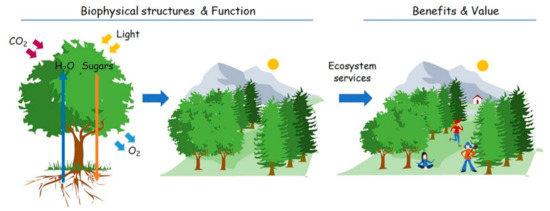
Figure 1. Schematic illustration of the concept of ecosystem services (inspired by de Groot et al. [46][47]), representing benefits and values for human well-being, deriving from plants and/or biophysical structures and functions implemented in green spaces.
In this context, the scope of this paper is to provide an overview of the benefits and limitations of applying an ecosystem services approach in designing GI, focusing on green roofs and community gardens. Many roofs are characterised by impermeable surfaces that have a direct effect on UHI, due to their vulnerability to flooding and energy consumption, and indirect effects on emission gases. The gardens of private and public spaces, such as closed gardens with ornamental vegetation, are often planned without considering the direct interaction between vegetation species, environmental matrix and social activities and needs. This produces a poor efficiency in the use of urban space [26][27][28][29][30][31][32]. Therefore, the integration of solutions with roofs and gardens can create GI which can represent strategies to provide ecological and social multifunctionality to waterproofed surfaces connected to the buildings and low-exploited gardens being the main areas that affect dense urban settlements. Therefore, stimulating an inclusive design of ecosystem services can help to increase the well-being of the population and reduce the negative impacts of urbanisation[17][38].
The design of green spaces to increase ecosystem services needs to adapt different scientific disciplines at different ecological and urban scales, such as single plant interactions with the surrounding environmental matrix, or the relationship of the vegetation with the municipality (macro-scale), neighbourhood (meso-scale) and individual buildings (micro-scale)[40][45][48]. Therefore, the green space has to be planned crossing various disciplines at a different survey scale to reduce the gap in the knowledge of single sectors or expertise.
2. Some samples
2.1. Ecosystem Services Provided by Urban Green Spaces
Table 1 summarises the main ecosystem services and related human benefits provided by urban green spaces. Specifically, urban green spaces reduce the heat-absorbing surface, increase solar protection, enhance cooling by shading and evapotranspiration (which help to mitigate the microclimate in the urban area), represent a sink for pollution, mask noise, filter out environmental pollutants by improving air quality and increase natural water retention [23][36][49][50][51][52]. Therefore, ecosystem services directly linked with urban green spaces are air filtration (gas regulation; carbon sequestration), micro-climate regulation, rainwater drainage (water regulation or stormwater management) and sewage treatment (waste treatment), the mitigation of disturbance regimes, with the increase of species diversity and composition, and cultural and educational values[9][53][54][55].
Table 1. Example of the main ecosystem services provided by green spaces in urban areas considering the TEEB classification (from 1 to 6 provisioning services; from 7 to 15 biological services; from 16 to 17 habitat services; and from 18 to 22 cultural and amenity services), with selected references useful for a further reading. The table was structured following the ecosystem services classification and the link between ecological processes and benefits developed by de Groot et al. [46][56].
| Ecological Processes | Ecosystem Services | Benefits | Selected References |
|---|---|---|---|
| Energy flow from solar radiation into edible plants and animals | 1—Food | Fruits Small scale subsistence |
[57][58][59][56][60][61][62][63] |
| Influences on material and energy flow of the ecosystem in biogeochemical cycles (CO2, ozone layer etc.) | 7—Air quality regulation | Reduction of the respiratory and cardiovascular illnesses and allergies | [9][7][18][31][44][57][63][64][65][66][67][68][69][70][71] |
| Evapotranspiration | 8—Climate regulation | Increase of shade and thermal comfort Reduction of heat-related illnesses Reduction of greenhouse gas emissions |
[9][17][31][44][57][72][67][66][71][68][69][70][73][74][75][76][77][78][79] |
| Increase of surface albedo | |||
| Flood prevention | 11—Water treatment | Reduction of disturbance events Increasing run-off volumes Discharge rates |
[9][17][36][44][57][61][62][67][80][81] |
| 9—Moderation of disturbance events | |||
| Filtering, retention and storage water | 10—Water regulation | ||
| Accumulation of organic matter | 12—Erosion prevention 13—Maintenance of soil fertility |
Maintenance of soil productivity | [44][57][61][70] |
| Living space suitable for wild plants and animals’ growth and reproduction | 14—Pollination 15—Biological control 16—Maintenance of life cycles of migratory species 17—Maintenance of genetic diversity |
Support biodiversity and genetic diversity | [9][44][57][58][61][62][63][68] |
| Attractive landscape elements | 18—Aesthetic information | Promotion of green lifestyles Increase of community engagement Provision of recreational green spaces Reduction of anxiety Positive effect on behaviour Attentional restoration Reduction of mental fatigue Improvement in cognitive functions, and ability to perform tasks Aesthetic appreciation Increased inspiration Increased recreational activities Improve the quality of physical function and/or health |
[17][44][55][82][57][54][61][62][63][68][83][84][85][86] |
| Diversity in the recreational use of the urban space | 19—Opportunities for recreation and tourism | ||
| Diversity in the values of cultural and artistic natural elements | 20—Inspiration for culture, art, and design | ||
| Diversity in the values of the spiritual and historic natural elements | 21—Spiritual experience | ||
| Diversity in the values of nature with scientific and educational implications | 22—Information for cognitive development |
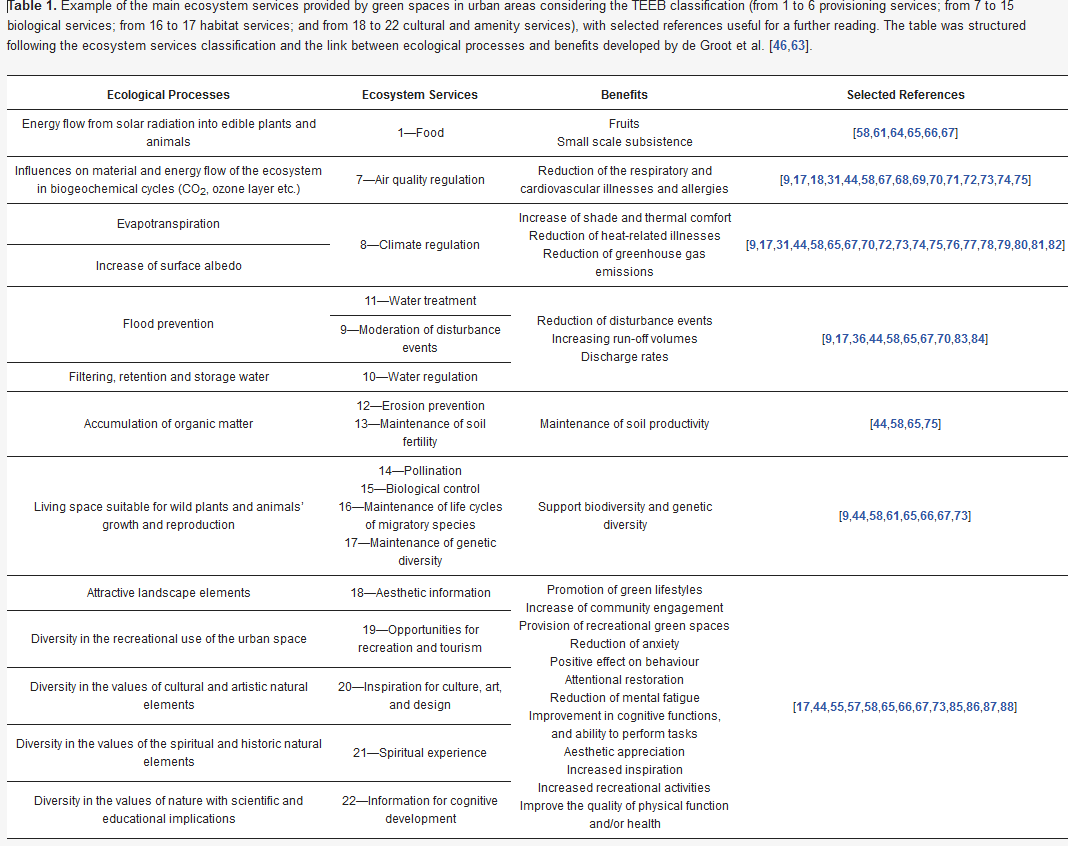
Urban green spaces also decrease stress to visitors, increase property values and make urban areas more attractive [31]. The interactions of people with green spaces promote psychological wellness, improve mood and attention and reduce stress and anxiety[82][57][72]. Other services such as food production and erosion control could have lesser value in the urban context, but may be considered relevant in metropolitan or regional areas [54][87][58][59].
Positive effects of green space on the direct and indirect production of ecosystem services are still not well acknowledged [47] and new perspectives can be opened by the implementation of new technologies. For instance, dendrochemistry is a consolidated tool for detecting the release of contaminants from human activities over time and is applicable to tree sprawl that has been present for many years in the urban context, for example[88]. Consequently, the urban ecosystem characterised by trees can offer important spatial-temporal information that is classifiable as services and benefits (not included in the TEEB classification) that can be incorporated into urban planning processes [88][89][90].
However, the provision of ecosystem services in public urban spaces is not sufficient to guarantee the quality of human life in growing cities. Private actions in private space need to take social responsibility; for example, by developing urban elements integrating functional biodiversity that is able to support ecosystem services to reduce the environmental impacts and increase human well-being[2][55][91][92]. It is important to apply multifunctional land use actions to guarantee the simultaneous use of space for human activities such as housing, and ecosystem services production such as stormwater retention, energy conversion and habitat creation, involving both the public and private sectors[93].
2.2. Green Roofs
Green roofs represent a strategy to transform the sealed and solar radiation heat surfaces of a rooftop into multifunctional ecological spaces[93]. In general, a green roof consists of vegetation, growth medium (substrate) and many other layers (drainage layer, waterproofing membrane etc.) to prevent negative effects of the interaction between vegetation and building structures and the healthiness of the building[94][95]. Considering the thickness of the substrate and the type of vegetation that it can sustain, green roofs are classified as follows [95]:
-
“Extensive green roof” with a substrate thickness lower than 15 cm and a weight of up to 100 kg/m2. It can be “single-course extensive”, with a thickness of 10 cm and characterised mainly by grass vegetation, or “multi-course extensive”, with a thickness of 15 cm and characterised by a mix of grass and shrubs;
-
“Intensive green roof”, with a thickness larger than 15 cm and an average weight of up to 1000 kg/m2. It can be distinguished into “semi-intensive”, with a thickness from 20 cm to 30 cm, and “intensive”, with a thickness larger than 30 cm.
-
“Extensive green roof” with a substrate thickness lower than 15 cm and a weight of up to 100 kg/m2. It can be “single-course extensive”, with a thickness of 10 cm and characterised mainly by grass vegetation, or “multi-course extensive”, with a thickness of 15 cm and characterised by a mix of grass and shrubs;
-
“Intensive green roof”, with a thickness larger than 15 cm and an average weight of up to 1000 kg/m2. It can be distinguished into “semi-intensive”, with a thickness from 20 cm to 30 cm, and “intensive”, with a thickness larger than 30 cm.
The first type can support grass and shrubs, whereas the second can support shrubs and low trees[93][96][97][98].
Green roofs are natural-based solutions used in public and private buildings to increase ecosystem services with positive effects on energy consumption, urban heat island impacts and greenhouse gas generation in urban areas [55][99].
Table 2.
Table 1 for details.
| Ecological Processes | Ecosystem Services | Benefits | Selected References |
|---|---|---|---|
| Energy flow from solar radiation into edible plants and animals | 1—Food | Fruits Small-scale subsistence |
[23[100][101][102][103][104][105][106][107] |
| Influences on material and energy flow of the ecosystem in biogeochemical cycles (CO2, ozone layer etc.) | 7—Air quality regulation | Evacuation of air pollutants such as particulate matter, carbon dioxide, nitrogen dioxide, carbon monoxide and sulphur dioxide Carbon sink Reduction of carbon footprints |
[65][95][100][107][106][108][109][110] |
| Evapotranspiration | 8—Climate regulation | Mitigation of heat flux into the building Reduction of energy demand for space climate conditioning Mitigations of the urban heat island effect Increase of thermal comfort Reduction of urban energy consumption Reduction of carbon footprints Decrease of cooling and heating |
[65][94][100][107][106][108][109][110][111][112][113][114][115] |
| Increase of surface albedo | |||
| Flood prevention Filtering, retention and storage water |
11—Water treatment | Reduction of stormwater volume Decrease of the burden of the water treatment facilities Improvement of rainwater use |
[23][65][94][100][116][117][118][106][108][109][110][115][111][112][113][114][119][120][121] |
| 9—Moderation of disturbance events | |||
| 10—Regulation of water flows | |||
| Living space suitable for wild plants and animals’ growth and reproduction | 14—Pollination 15—Biological control 16—Maintenance of life cycles of migratory species 17—Maintenance of genetic diversity |
Provision of habitat for insect and animals Implementation of vegetation biodiversity and improved landscape |
[65][93][100][107][106[108][109][110][121][120][122][123][124] |
| Attractive landscape features | 18—Aesthetic information | Relaxation and recreation Provision of recreational space Decrease of the noise pollution |
[65][86][100][107][106][108][125] |
| Diversity in the recreational use of the urban space | 19—Opportunities for recreation and tourism | ||
| Diversity in the values of cultural and artistic natural elements | 20—Inspiration for culture, art and design | ||
| Diversity in the values of the spiritual and historic natural elements | 21—Spiritual experience | ||
| Diversity in the values of nature with scientific and educational implications | 22—Information for cognitive development |
The intensive green roof can produce more ecosystem services and better sustain human health in the city with respect to extensive ones, emphasising the use of public spaces and raising aesthetic expectations. However, it needs more building structural support, with costs related to its realisation and maintenance [94][96][100]. On the other hand, the extensive green roof presents less weight, does not require irrigation and has lower capital and maintenance costs; therefore, this is the most commonly used[100][116][117]. It has also been proven to be effective in mitigating floods. Indeed, it was estimated that it has the capacity to reduce the stormwater volume from 50% to 60% of total annual precipitation [117][118].
Introducing vegetation onto the roof may help to increase biodiversity in urban areas. However, since green roofs are artificially created habitats with different environmental conditions with respect to natural conditions, such as high radiation and temperature, the use of autochthonous vegetation may be difficult to apply and not always feasible. Therefore, the use of green roofs has to disregard conservation actions that require the use of local vegetation because it could make this strategy ineffective and expensive. Different vegetation can be planned: officinal plants, aromatic plants, fruits etc. with the idea to create widespread urban gardens. This could be a characterising element of a neighbourhood and a point of attraction. In this perspective, green roofs could become enjoyable areas for social activities[55].
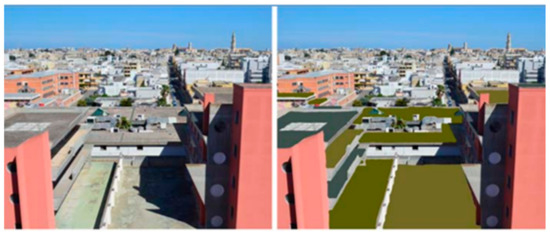
Figure 2.
left
right).
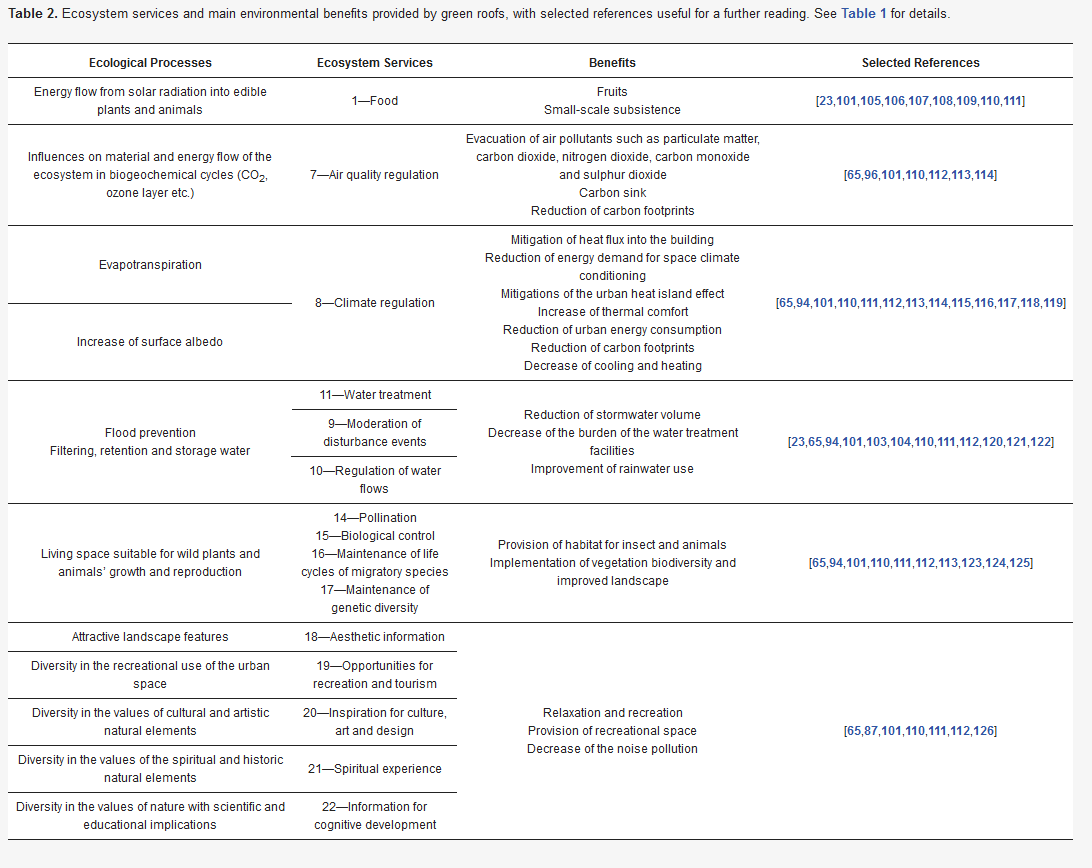
New Frontiers of Green Roofs
Recently, hybrid photovoltaic (PV) green roofs have been proposed as a new perspective of the natural-based solution in the green roof industry, since they enhance the electrical yield[100][126]. The vegetation can reduce the surrounding temperature of PV panels, while at the same time being less exposed to the sun by PV panels. The increase in the energy efficiency of PV green roofs has been estimated to range from 1.3% to 8.3% compared to the traditional installation of PV systems [126][127][128].
In this perspective, an important example is represented by the solution introduced from the Korea Institute of Civil Engineering and Building Technology. It developed a “green-blue roof” that provides the possibility to introduce a green area and water storage in the roof in one solution. The roof is characterised by a vegetation layer on the water layer. This solution can store more water, decreasing the runoff and avoiding flash flooding effects, and can store the water that can be employed for domestic use[129][130].
These extreme solutions can be reconsidered when analysing natural resource availability in the future. For instance, the World Resources Institute estimated that there will be a reduction in water availability for human use in many parts of the world by 2050 [131]. These events have not happened to date, although the first real water crisis occurred in Cape Town between 2017 and 2018, when the population lived on 50 litres of water per day; the inhabitants were forced to adapt their daily habits, and the main security problem was water theft.
2.3. Community Gardens
The concept of urban community gardens is generally linked to the practice of growing crops in urban and peri-urban areas[132][133][134]. It provides food products, as well as aromatic and medicinal herbs, ornamental plants etc. [132]. Urban agriculture does not have a fixed dimension or preferable urban space but can be performed in any shape and in different places, such as brownfield sites, roofs, greenfield sites (i.e., parks, gardens) etc.[135][136]. In the urban context, agriculture can represent a multifunctional land-use strategy[138], because it can integrate agriculture activities with social and ecological function purposes[137].
In the context of biodiversity loss, food insecurity and social alienation due to urbanisation, urban community gardens can represent sites for urban residents to reconnect with nature in a social environment creating common spaces and new forms of community interaction and corporations [136][140]. Ecosystem services and related benefits for human well-being are summarised in
Table 3.
Table 1 for details.
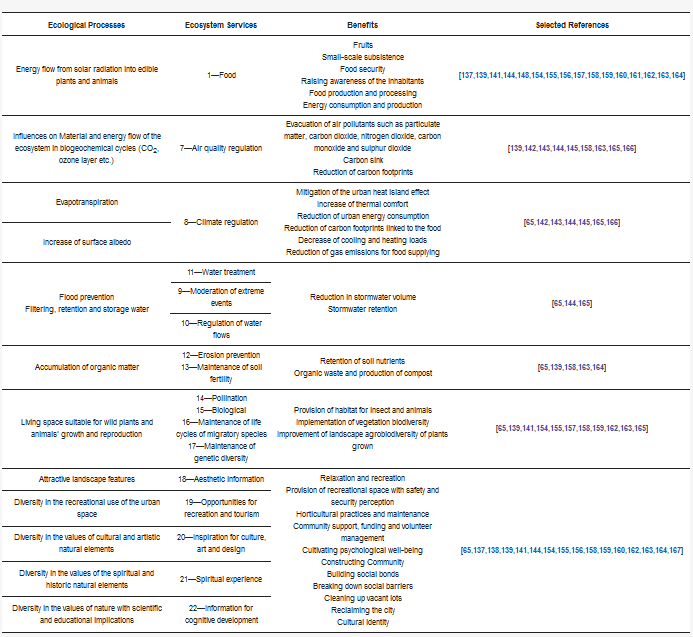
| Ecological Processes | Ecosystem Services | Benefits | Selected References |
|---|---|---|---|
| Energy flow from solar radiation into edible plants and animals | 1—Food | Fruits Small-scale subsistence Food security Raising awareness of the inhabitants Food production and processing Energy consumption and production |
[130][136][140][143][147][153][154][155][156][157][158][159][160][161][162][163] |
| Influences on Material and energy flow of the ecosystem in biogeochemical cycles (CO2, ozone layer etc.) | 7—Air quality regulation | Evacuation of air pollutants such as particulate matter, carbon dioxide, nitrogen dioxide, carbon monoxide and sulphur dioxide Carbon sink Reduction of carbon footprints |
[138][142][143][144][157][162][164][165] |
| Evapotranspiration | 8—Climate regulation | Mitigation of the urban heat island effect Increase of thermal comfort Reduction of urban energy consumption Reduction of carbon footprints linked to the food Decrease of cooling and heating loads Reduction of gas emissions for food supplying |
[64][141][142][143][164][165] |
| Increase of surface albedo | |||
| Flood prevention Filtering, retention and storage water |
11—Water treatment | Reduction in stormwater volume Stormwater retention |
[64][143][164] |
| 9—Moderation of extreme events | |||
| 10—Regulation of water flows | |||
| Accumulation of organic matter | 12—Erosion prevention 13—Maintenance of soil fertility |
Retention of soil nutrients Organic waste and production of compost |
[64][138][157][162][163] |
| Living space suitable for wild plants and animals’ growth and reproduction | 14—Pollination 15—Biological 16—Maintenance of life cycles of migratory species 17—Maintenance of genetic diversity |
Provision of habitat for insect and animals Implementation of vegetation biodiversity Improvement of landscape agrobiodiversity of plants grown |
[64][138][140][153][154][155][156][157][158][159][160][161][162][163] |
| Attractive landscape features | 18—Aesthetic information | Relaxation and recreation Provision of recreational space with safety and security perception Horticultural practices and maintenance Community support, funding and volunteer management Cultivating psychological well-being Constructing Community Building social bonds Breaking down social barriers Cleaning up vacant lots Reclaiming the city Cultural identity |
[64][[136][137][138]1[141][143][153][154][155][156][158][159][160][161][162][163][164][165][166][157] |
| Diversity in the recreational use of the urban space | 19—Opportunities for recreation and tourism | ||
| Diversity in the values of cultural and artistic natural elements | 20—Inspiration for culture, art and design | ||
| Diversity in the values of the spiritual and historic natural elements | 21—Spiritual experience | ||
| Diversity in the values of nature with scientific and educational implications | 22—Information for cognitive development |
Specifically, urban community gardens contribute to ecological sustainability by providing agroecosystems that can improve soil quality and reduce soil erosion rainwater runoff [138][139][137]. They can also impact on climate change/urban microclimates and stimulate the productive reuse of urban organic waste, thus reducing the urban resource footprint[140]. The social and economic goods and benefits of community gardens include increasing access to fresh fruits and vegetables, building community ties and community economic revitalisation, and regenerating vacant, neglected, or disturbed urban spaces. The community gardens are useful for promoting a sense of individual well-being and health in urban areas where there is social isolation and cultural diversity, promoting cross-cultural communication. Moreover, community gardens can improve cultural and educational ecosystem services by connecting people to the cycles of the earth, biodiversity and natural processes and improving people’s practical gardening skills[141][142][143][144].
Community gardens can reinforce people’s relations using food production, such as the urban activity of social and cultural connections, by bringing together diverse groups of people, stimulating the sharing of agricultural and culinary knowledge, and creating stronger bonds in the community [145]. Community gardens are also considered “participatory landscapes” of resistance to racism and marginalization through collective work and self-reliance [146][147][148].
New Frontiers for Urban Community Gardens
The new frontiers for urban community gardens are to combine food and urban design to produce material pushed from strong synergies between waste production in the building and the capacity of urban community gardens to recycle urban waste, such as organic matter, wastewater and waste heat [149]. This combination can develop an urban system that is able to reuse residential or industrial waste resources with benefits including food production for local consumption and the reduction of the consumption of natural resources[150]. This strategy can be achieved by creating a low or even “no-input system” around a sustainable food infrastructure [151][152]] that produces a “closed-loop entity” in terms of waste recycling that is able to reduce pollution[150]. The connection of urban needs, ecological and productive activities at the scale of the building is a strong ambition that can support the sustainability of the cities, reducing the environmental impacts generated by urban waste[150][153][154].
